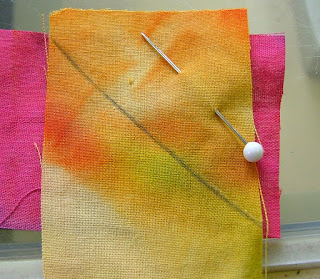Blog 258
Dilys’s
Multi-coloured Dream Quilt Part 7
I made the decision last week to make another 7 blocks to
balance the squares in the quilt. Those were the hardest ones to make having
already cleared away the mess from piecing the last 65 blocks. Again, I had to
iron bits of fabric, cut 1 ½” strips and join them together, resize and sew.
What a chore!! BUT all the squares are done and many of them are layered and
ready for quilting. I have selected 2 variegated threads so that the top one
will blend with all the fabric colours and the one on the back will look
colourful against the dyed fabric squares I am using. I have had to reorder
these threads as I have quilted lots of blocks and run out.
BTW: I forgot to mention
last week that I have chosen to use squares of dyed fabric for the back of the
quilt. Each time I visit the NEC for the Festival of Quilts, I usually treat
myself to a piece of fabric dyed by Heidi Stoll-Weber. It’s colourful, it’s expensive but it’s
fabulous. I have just stock-piled it over the years because I haven’t been able
to cut into it because I love it so much. So I asked myself what is the point
in having this fabric if I am not going to enjoy using it? I mentally jumped
over that hurdle and started to cut into it with enthusiasm! (Though in the
back of my mind I know that I am going to the NEC in 11 sleeps time and I will
be able to buy some more!!!)
The layered blocks are all going to be machine quilted with
a meandering ‘fluffy cloud’ pattern which fills in the space in no time at all
without being too intense. (I did toy with the idea of doing them all
differently for all of 3 seconds, but then decided that it was too much like
hard work!)
TIP: I usually practice
whatever pattern I am going to do with pencil and paper first, just to get the
rhythm of the design into my head and onto my fingertips.
Here are my thoughts on machine quilting: When you write,
you pull the pencil across the paper which is of course not moving. When you do
machine quilting, the needle (pencil) is forming the stitch on the spot and you
move the fabric (paper) in relation to the needle. Successful machine quilting
is a delicate balance of the speed of the stitch (made by the pressure of the
foot on the pedal) and the speed of moving the fabric. Practice makes perfect
and you don’t get good at something by not doing it!
Here’s the pile of blocks waiting to be sandwiched and
quilted. There’s still a long way to go.
The next stage is to join the blocks together like the ones
below.
Because I am placing the blocks on point, I have to make
triangles for the ends of the rows and corners. More next week.
It’s a good thing to be quilting on a rainy day like today.
After all, I could be a squirrel.








































